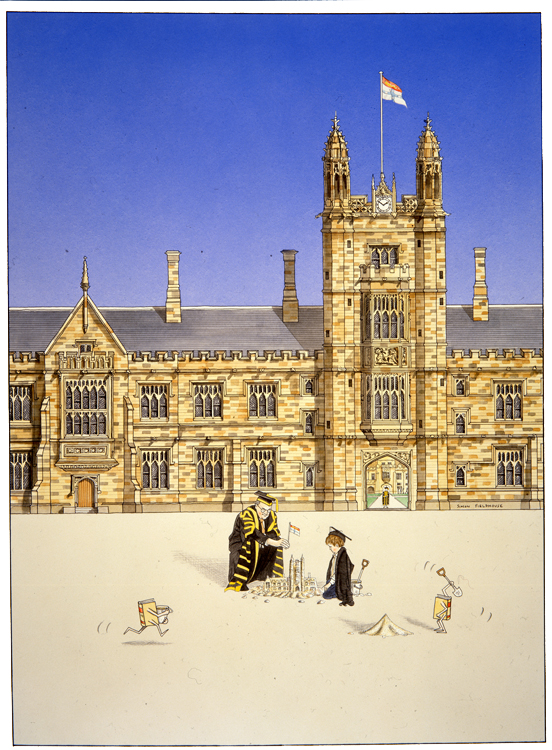
The University of Sydney Clocktower
The University of Sydney Clocktower: An Iconic Symbol of Academic Excellence
Standing tall and proud in the heart of the University of Sydney's Camperdown campus, the University of Sydney Clocktower has long been an iconic symbol of academic excellence and a beloved landmark for students and visitors alike. This elegant structure, which combines elements of Gothic and Romanesque architecture, not only tells the time but also tells a story of the institution's rich history and its commitment to higher education.
The University of Sydney, established in 1850, is Australia's oldest university, and the Clocktower, erected in 1920, is a testament to the enduring legacy of this institution. At its core, this impressive tower is a utilitarian structure, housing the university's chimes and a carillon, which produce melodious tunes that reverberate across the campus. It serves a practical purpose, keeping time for the university community. Yet, it is more than a mere timekeeper; it represents the timeless pursuit of knowledge and the importance of preserving tradition.
The Clocktower's architectural design is nothing short of breathtaking. The sandstone exterior, adorned with intricate carvings and the university's coat of arms, exudes an air of grandeur and history. Its soaring spire, with its weathervane crowning the summit, adds to the building's dignified appearance. The clock faces, adorned with ornate Roman numerals and striking blue hands, can be seen from various vantage points on campus. These aesthetic elements embody the notion that academic pursuits are not merely pragmatic but also rooted in aesthetics, culture, and tradition.
Beyond its visual appeal and practical function, the Clocktower holds immense sentimental value for the University of Sydney's community. It is a place of gathering, celebration, and reflection. Many students find themselves taking graduation photos in its shadow, and its bells have signaled countless commencements, marking the start of new academic journeys. Its presence is a constant reminder of the institution's mission to educate and inspire generations of scholars.
Moreover, the Clocktower serves as a hub of campus life. Underneath the tower, the cloisters provide a space for students to study, chat, or simply enjoy a moment of respite. Its proximity to the Fisher Library, the Quad, and the Great Hall makes it a central point for student activities and a convenient location for students to meet and engage with one another.
In conclusion, the University of Sydney Clocktower is more than just a timekeeping structure; it is a symbol of the institution's commitment to academic excellence and its rich history. Its architectural beauty, rich tradition, and central location make it an integral part of campus life. It stands as a testament to the enduring values of education, knowledge, and community, and its iconic presence serves as a reminder of the enduring pursuit of learning that takes place within the university's walls. As a beacon of knowledge and a source of inspiration, the University of Sydney Clocktower continues to play a significant role in the life of the university and the hearts of those who pass by it each day.
In the realm of higher education, visionary leadership is a cornerstone of success. For the University of Sydney, Gavin Brown, who served as the Vice Chancellor from 2008 to 2012, stands out as a prime example of such leadership. His tenure was marked by transformative initiatives, a deep commitment to academic excellence, and an unwavering dedication to the university's mission.
Gavin Brown's appointment as the Vice Chancellor of the University of Sydney was met with high expectations, and he did not disappoint. Under his guidance, the university initiated a series of strategic reforms and investments aimed at furthering its status as a global academic powerhouse. Brown understood the importance of fostering a culture of innovation and excellence, and he set out to implement his vision with vigor.
One of his most notable accomplishments was the establishment of the Sydney Institute for Emerging Technologies and Society (IETs), which exemplified his forward-thinking approach. This initiative aimed to bring together experts from various fields to address complex global challenges, reflecting the university's commitment to interdisciplinary collaboration and research. The IETs has since become a hub for cutting-edge research in fields such as artificial intelligence, biotechnology, and climate science.
Gavin Brown also recognized the importance of diversity and inclusivity in academia. He launched initiatives to promote gender equality and diversity, fostering an environment where all students and faculty could thrive. His commitment to making the university a more inclusive institution resonated with many and laid the foundation for a more equitable academic community.
Furthermore, Brown was instrumental in strengthening the University of Sydney's global presence. He understood the significance of international collaborations and expanded partnerships with other world-renowned universities. This approach allowed for greater student mobility, knowledge exchange, and global research engagement. As a result, the university became more diverse and interconnected, further enhancing its academic reputation.
Brown's leadership extended to the realm of sustainability. Under his guidance, the university made significant strides in its sustainability efforts. Initiatives were launched to reduce the university's carbon footprint, with a focus on sustainable practices and responsible stewardship of resources. These efforts aligned with the global commitment to addressing climate change and served as a model for other institutions.
In sum, Gavin Brown's tenure as Vice Chancellor of the University of Sydney was marked by innovation, inclusivity, global engagement, and sustainability. His visionary leadership left an indelible mark on the institution, shaping it into a more dynamic, forward-thinking, and globally influential university. His dedication to academic excellence and commitment to addressing the challenges of the modern world made him a true luminary in the world of higher education, and his legacy continues to inspire and guide the University of Sydney to this day.